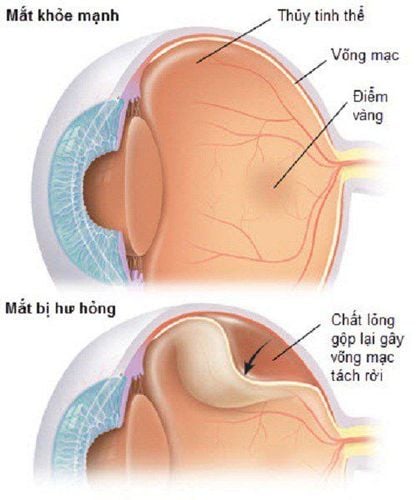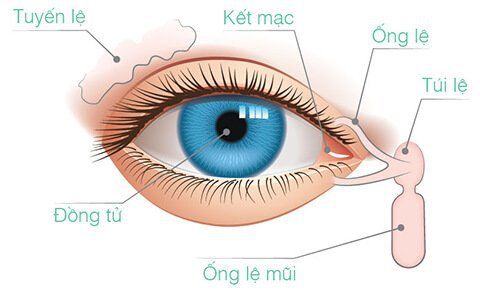This is an automatically translated article.
The article was professionally consulted by an eye doctor - Department of Examination & Internal Medicine - Vinmec Hai Phong International General HospitalVitreous detachment, also known as a degenerative condition of the vitreous, can cause blurred vision, flashes of light, or floating streaks in the eye.
1.Overview
Vitreous is located inside the lumen of the eye in the form of a transparent gel that fills the space between the lens and the retina of the eye, helping the eye to keep its anatomical shape.
Vitreous consists of 2 components:
A fibrous part consisting of albumin molecules bound together, quite sensitive to light. The translation (98% is water). The vitreous is firmly attached to the retina at the fundus sites (around blood vessels, macula, optic discs). When this part is pulled and separated from the retina, it is called vitreous detachment.
2. Is vitreous detachment dangerous?

Rách võng mạc
In some people with eye disease or the elderly, the vitreous gradually changes: liquefies, shrinks or attaches too firmly to the retina causing retinal tear, from which the vitreous fluid enters through the tear. This causes the retina to separate from the fundus of the eye, leading to retinal detachment. Thus, a small percentage of eyes with vitreous detachment can lead to complications of retinal detachment causing partial or complete loss of vision (depending on the area of retinal detachment), remaining in most cases. Vitreous detachment is a fairly benign, natural progression that is not a serious vision threat and does not require treatment.
3. Cause
The cause of vitreous detachment is often related to age. As we age, the vitreous will naturally become more watery, reduce its gel-like substance, making it difficult to keep its normal shape, and then gradually move from the retina (which is at the back of the eye) towards the center. eye causes vitreous detachment. It is estimated that more than 75% of people over the age of 65 develop vitreous detachment, so this is a natural condition, not reflecting any serious health problems.
People over 50 years old, especially those over 80 years old and people with refractive errors often have a high risk of vitreous detachment, the patient can have vitreous detachment in one eye or both eyes.
4. Symptoms

Khi bị bong dịch kính có thể dẫn tới xuất huyết dịch kính
When vitreous detachment leads to complications of retinal tear or vitreous hemorrhage, the patient will see a small but sudden increase in bright flashes, flies, curtain marks, floating shadows in the field of vision. This increase in a few cases can lead to more complicated complications such as: detachment of the retina or pre-retinal membrane, macular contraction, macular hole... visual acuity) should be examined and treated early.
Often patients will not realize they have a vitreous detachment or are only mildly bothered by the presence of shadows that interfere with vision.
5. Treatment of vitreous detachment
People who experience a sudden increase in floating shadows or bright flashes in their peripheral vision should proactively visit an ophthalmologist for an examination, examination, and evaluation of their eye condition as soon as possible. Because vitreous liquefaction is a natural aging process, there is currently no cure for it. Therefore, in the daily diet should be fortified and supplemented with antioxidants, vitamins that are good for the eyes can help protect the integrity of the vitreous.If you are experiencing vision problems, go to a medical facility immediately to be examined and treated by doctors as soon as possible. Currently, Vinmec International General Hospital has vision-related service packages such as:
Refractive error screening package Cataract surgery consultation and examination package Ortho-K package
Please dial HOTLINE for more information or register for an appointment HERE. Download MyVinmec app to make appointments faster and to manage your bookings easily.













